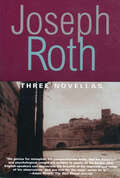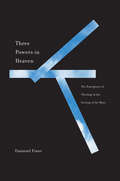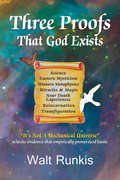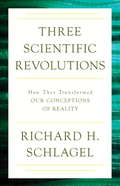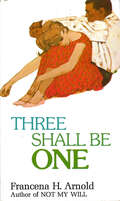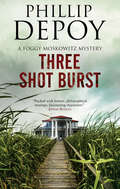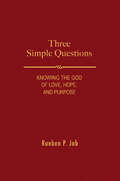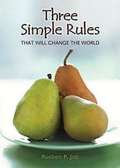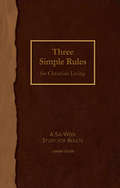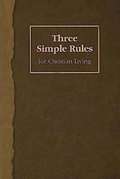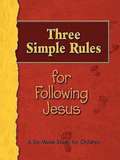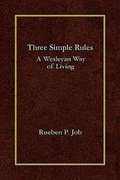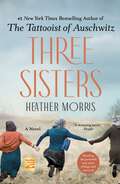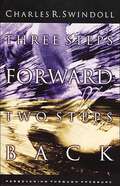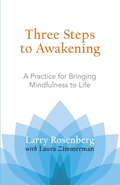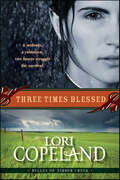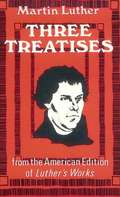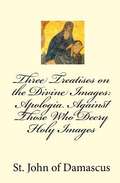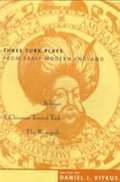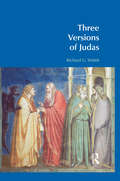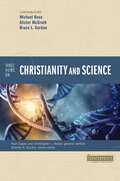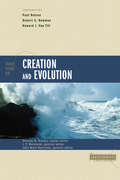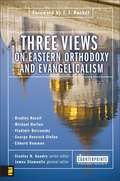- Table View
- List View
Three Novellas: THE LEGEND OF THE HOLY DRINKER, FALLMERAYER THE STATIONMASTER AND THE BUST OF TH
by Joseph RothThis collection showcases the renowned author’s “genius for metaphor, his compassionate irony, and his historical and psychological insight” (The Wall Street Journal).Austrian author Joseph Roth was one of Europe’s most powerful and perceptive literary voices during the turbulent period between WWI and WWII. This collection presents three of his most enduring works of fiction. “The Legend of the Holy Drinker” tells the story of a dissolute vagrant who is uplifted for a short time by a series of miracles. Written in the final days of Roth’s life, it is a novella of sparkling lucidity and humanity. “Fallmerayer the Stationmaster” and “The Bust of the Emperor” are Roth’s most acclaimed works of shorter fiction.
Three Powers in Heaven: The Emergence of Theology and the Parting of the Ways (Synkrisis)
by Emanuel FianoA fresh look at how Christianity and Judaism became two distinct religions through the parting of their intellectual traditions How, when, and why did Christianity and Judaism diverge into separate religions? Emanuel Fiano reinterprets the parting of the ways between Jews and Christians as a split between two intellectual traditions, a split that emerged within the context of ancient debates about Jesus’s relationship to God and the world. Fiano explores how Christianity moved away from Judaism through the development of new practices for religious inquiry. By demonstrating that the constitution of communal borders coincided with the elaboration of different methods for producing religious knowledge, the author shows that Christian theological controversies, often thought to teach us nothing beyond the history of dogma, can cast light on the broader religious landscape of late antiquity. Three Powers in Heaven thus marks not only a historical but also a methodological intervention in the study of the parting of the ways and in scholarship on ancient religion.
Three Proofs That God Exists: That God Exists
by Walt RunkisScientifically combining Eastern mysticism and Western metaphysics with miracles and magic, and elements from near-death experiences, death-related visions, proven accounts of reincarnation, archaeological evidence, and an esoteric grasp of the arcane mysteries, Three Empirical Proofs shine forth. This structure of empirical evidence proves, to a "statistical certainty," that all of these diverse phenomena are the intricately interrelated workings of the "Non-Mechanical Universe," the Cosmic Consciousness that we call God. Walt Runkis is an autodidact and Renaissance man: scientist, inventor, artist, goldsmith, author, and serial entrepreneur. He has two patents issued in immunochemistry, plus three patents issued and one pending in cryptographic network cyber security. Walt was born with a high IQ and an insatiable curiosity. His left brain delved deeply enough into chemistry and physics to give him a basic understanding of how the mechanical universe works, while his right brain stretched his consciousness far enough to know it is not a mechanical universe in which we live. Walt was a decorated Sergeant E-5 in the U.S. Marine Corps, where he served as a Marine ASRAT for a year in Chu Lai and Marble Mountain, Vietnam (1965-66).
Three Scientific Revolutions
by Richard H. SchlagelScience has had a profound influence in shaping contemporary perspectives of reality, yet few in the public have fully grasped the profound implications of scientific discoveries. This book describes three intellectual revolutions that led to the current scientific consensus, emphasizing how science over the centuries has undermined traditional, religious worldviews.The author begins in ancient Greece, where the first revolution took place. Beginning in the sixth-century BCE, a series of innovative thinkers rejected the mythology of their culture and turned to rational analysis and the empirical study of reality. This change in thinking, though it lay dormant for the many centuries of Christian hegemony in the West, eventually gave rise to the Enlightenment of the 17th and 18th centuries--the second revolution. Highlighted by such luminaries as Kepler, Galileo, and Isaac Newton, the Enlightenment laid the foundations for our current understanding of the world.Today we live amidst the third scientific revolution, including Darwin's theory of evolution, Planck's concept of the quantum, Einstein's relativity theories, Bohr's quantum mechanics, along with Watson and Crick's decoding of the human genome with the prospect of improving human nature. Besides technological wonders, this revolution has also supported widespread respect for freedom of thought, greater educational opportunities, and democratic governments. Looking to the future, Schlagel sees many exciting possibilities yet also potentially devastating threats to the environment. He underscores the need for widespread scientific literacy, stressing that only unfettered scientific inquiry offers a realistic hope of overcoming these daunting challenges.From the Trade Paperback edition.
Three Shall Be One
by Francena H. ArnoldIn spite of difficult circumstances in the first few years of marriage, Tony and Linda never doubted each other&’s love. Until Tony&’s controlling mother arrives. A compelling drama of the unexpected seems to seal off any return to their early married happiness, yet an astounding chain of events sets them on the path to restoration.
Three Shall Be One
by Francena H. ArnoldIn spite of difficult circumstances in the first few years of marriage, Tony and Linda never doubted each other&’s love. Until Tony&’s controlling mother arrives. A compelling drama of the unexpected seems to seal off any return to their early married happiness, yet an astounding chain of events sets them on the path to restoration.
Three Shot Burst: Severn House Publishers (The Foggy Moskowitz Mysteries #2)
by Phillip DePoyAn &“emotion-filled story of family dynamics and self-discovery . . . brimming with interesting characters&” from the bestselling author of The Liverpool Trilogy (Booklist). Foggy Moscowitz is called to Mary&’s Shallow Grave, everyone&’s favorite bar. A man has been killed—shot three times—by a young girl. With no parents, no fixed abode, and no services to help her, Foggy is forced to shelter her in his beachside apartment. The victim was the son of the richest Seminole in Florida, Ironstone Waters, who sends several of his men, including Mister Redhawk, to collect the girl and find out what happened. With Ironstone&’s men, a Colombian drug cartel, and the police all in pursuit, Foggy has nowhere to turn but to John Horse. With some help from the Seminole mystic, Foggy realizes some disturbing truths. The latest hard-boiled mystery in the Foggy Moscowitz series is &“packed with humor, philosophical musings, [and] fascinating characters&” (Kirkus Reviews).
Three Simple Questions: Knowing the God of Love, Hope, and Purpose
by Rueben P. JobRueben P. Job, author of Three Simple Rules, brings us a new insight on how to live a Christ-like life and explores the three most basic and profound questions at the center of our faith—questions that all major religions try to answer and around which there seems to be much confusion:Who is God?Who am I?Who are we together?In three brief and engaging chapters, readers will explore these questions and gain new understanding of the answers:Know that God is greater than you can imagineBelieve that you are God's beloved childBe the love of Christ in the worldThey will also discover the greatness and goodness of God, the value of every beloved child of God, and the impact we can have in the world when we live as Jesus lived.Each chapter concludes with a simple spiritual practice to help readers remember and respond to what they have read, followed by a prayer.Now it is time for you to know, believe and become the answers.In its first paragraphs, Three Simple Questions triggered my hunger for hope. I hung on each word thereafter. By the time I finished my reading, I was filled to overflowing. I was drawn deeper by the notion of a God too small. Prayer as the place where we receive our identity was profound. I cheered with the truth that God loves all. I was intrigued by the imagery of my being a "holy chalice." The three daily practices are refreshing and engaging. In short, the read filled me with grace. —Bishop Sharon Brown Christopher
Three Simple Rules That Will Change the World
by Rueben P. JobThere is no one secret to life. But there are three simple rules that have the power to change your life and your world. John Wesley taught and practiced these rules many years ago. Now it is up to us to practice this way of living. Do no harm, Do good, Stay in love with God...Not only can these rules change your life, they can change the world. This insightful work calls us to mutual respect, unity, and a deeper daily relationship with God.
Three Simple Rules for Christian Living Leader Guide: A Six-Week Study for Adults
by Rueben P. Job Jeanne Torrence FinleyThis small-group study by Jeanne Torrence Finley is based on Rueben P. Job's book Three Simple Rules: A Wesleyan Way of Living. Six sessions provide extended reflection for adults on three principles ofChristian life: do no harm, do good, and stay in love with God. Eachrule has a session to help you understand the rule and a session to helpyou explore ways to practice the rule. The Leader Guide containseverything needed to guide a group through the6-week study, including session plans, discussion questions, and otheruseful information for organizing, leading, and publicizing your studygroup.
Three Simple Rules for Christian Living: A Six-Week Study for Adults
by Rueben P. Job Jeanne Torrence FinleyThree Simple Rules for Christian Livingby Jeanne Torrence Finley and Rueben P. JobThis small-group study by Jeanne Torrence Finley is based on Rueben P. Job's book Three Simple Rules: A Wesleyan Way of Living. Six sessions provide extended reflection for adults on three principles of Christian life: do no harm, do good, and stay in love with God. Each rule has a session to help you understand the rule and a session to help you explore ways to practice the rule. Three Simple Rules for Christian Living includes a DVD that contains excerpts from an interview with Bishop Rueben Job and a CD ROM that contains a Leader Guide for the study sessions and other useful information for organizing, leading, and publicizing study groups.Your church can do a church-wide study of the three simple rules by using the youth resource, Three Simple Rules 24/7, and the children’s resource, Three Simple Rules for Following Jesus, along with this book. A leader guide and DVD for adult study groups are available.Parents who would like to discuss the three simple rules with their children can download a free list of suggested questions at Cokesbury.com (click below). Jeanne Torrence Finley is a clergy member of the Virginia Conference of the United Methodist Church, co-chair of the Virginia Conference Board of Church and Society, and director of Collegial Communications. She has worked as a campus minister, pastor, college English teacher, workshop leader, and communications consultant. Finley writes regularly for FaithLink. Her work has appeared in the Journal of Presbyterian History, Worship, The Mennonite, Christian Science Monitor, the Virginia Advocate, and Christian Social Action.For a free online copy of Three Simple Rules A Conversation Guide for Parents click here!
Three Simple Rules for Following Jesus Leader's Guide: A Six-Week Study for Children
by Various Linda R WhitedIdeal for showing children how to be effective stewards of the world around themThis leader's resource helps plan six sessions that will help children:• Learn what it means to care for the world and God’s people• Consider the ways to do good things for their families, their church, their community, and the world• Discover the value of spiritual disciplines and how to practice themThe three simple rules of "Do No Harm," "Do Good," and "Stay in Love with God" are easy enough for children to understand and profound enough to begin a lifelong journey of faith.
Three Simple Rules: A Wesleyan Way of Living
by Rueben P. JobIn Three Simple Rules, Rueben Job offers an interpretation of John Wesley's General Rules for today's readers. For individual reading or group study, this insightful work calls us to mutual respect, unity and a deeper daily relationship with God. This simple but challenging look at three commands, "do no harm, do good, stay in love with God," calls us to mutual respect, unity, and a deeper relationship with God."Every year I review the three general rules of the United Methodist Church with those who are being ordained. Now I have a wonderful ordination gift to give them in Bishop Job’s, Three Simple Rules, to start and deepen the conversation as they enter a new relationship with the church. Bishop Job has described "by attending upon all the ordinances of God" to be to "stay in love with God." It’s a fresh language that speaks especially to long-time Christians and United Methodists." Sally Dyck, Resident Bishop, Minnesota Area"Three Simple Rules is a new catechism for everyone wanting to follow Jesus Christ. These practices for holy living should replace the membership vows in every church! Don’t let the title fool you. Bishop Job writes, ‘The rules are simple, but the way is not easy. Only those with great courage will attempt it, and only those with great faith will be able to walk this exciting and demanding way.’" John Hopkins, Resident Bishop, East Ohio AreaTable of Contents: IntroductionThe World In Which We LiveFirst Do No HarmDo All the Good You CanStay in Love with GodA Guide for Daily Prayer
Three Sisters: A Novel
by Heather MorrisFrom Heather Morris, the New York Times bestselling author of the multi-million copy bestseller The Tattooist of Auschwitz and Cilka's Journey: a story of family, courage, and resilience, inspired by a true story.Against all odds, three Slovakian sisters have survived years of imprisonment in the most notorious death camp in Nazi Germany: Auschwitz. Livia, Magda, and Cibi have clung together, nearly died from starvation and overwork, and the brutal whims of the guards in this place of horror. But now, the allies are closing in and the sisters have one last hurdle to face: the death march from Auschwitz, as the Nazis try to erase any evidence of the prisoners held there. Due to a last minute stroke of luck, the three of them are able to escape formation and hide in the woods for days before being rescued.And this is where the story begins. From there, the three sisters travel to Israel, to their new home, but the battle for freedom takes on new forms. Livia, Magda, and Cibi must face the ghosts of their past--and some secrets that they have kept from each other--to find true peace and happiness. Inspired by a true story, and with events that overlap with those of Lale, Gita, and Cilka, The Three Sisters will hold a place in readers' hearts and minds as they experience what true courage really is.
Three Steps Forwards, Two Steps Back: Persevering Through Pressure
by Charles SwindollCharles Swindoll reminds readers that our problems are not solved by simple answers or all-too-easy cliches. Instead, he offers practical ways to walk with God through the realities of life-including times of fear, stress, anger and temptation.
Three Steps to Awakening: A Practice for Bringing Mindfulness to Life
by Larry Rosenberg Laura ZimmermanThe deceptively simple three-phase method presented here is a meditation practice that can be worked with for a lifetime. Larry Rosenberg looks to Zen, to Insight Meditation, and to the teachings of J. Krishnamurti to find three kinds of meditation that anyone can do and that complement each other in a wonderful way: (1) breath awareness, (2) breath as anchor, and (3) choiceless awareness.Having the three methods in one's repertoire gives one meditation resources for any life situation. In a time of stress, for example, one might use breath awareness exclusively. Or on an extended retreat, one might find choiceless awareness more appropriate. The three-step method has been taught to Larry's students at the Cambridge Meditation Center in Cambridge, Massachusetts, for many years.After teaching the three-step method, Larry goes on to show how to bring the awareness gained in meditation to the world off the cushion, into relationships and into all areas of daily life.
Three Times Blessed (Belles of Timber Creek #2)
by Lori CopelandHow will Audrey and her fellow schoolmarms stay afloat when a flood threatens their small Texas town?Typically, Thunder Ridge, Texas, is dry as a bone. But Audrey Pride has arrived under a storm cloud, one that is deluging the shocked community with weeks of relentless, drenching rain. With travel in and out of town rendered impossible, there is much important work for her to do—especially when an epidemic of violent illness, originating from a stranded wagon train, spreads rapidly throughout Thunder Ridge. Caring for the sick is consuming Audrey's every waking hour...yet her thoughts keep returning to the attractive widower Eli Gray.Eli has long been haunted by the fact that he was away at war when his beloved wife died in childbirth. Little by little, however, he is opening his heart again. Now, as their town sags under the crushing weight of water and disease, Audrey and Eli will need to depend on each other in ways they never imagined possible.
Three Treatises
by Martin LutherMartin Luther posted his Ninety-five Theses on the church door at Wittenberg in 1517. In the three years that followed, Luther clarified and defended his position in numerous writings. Chief among these are the three treatises written in 1520. <P><P>In these writings Luther tried to frame his ideas in terms that would be comprehensible not only to the clergy but to people from a wide range of backgrounds. To the Christian Nobility of the German Nation is an attack on the corruption of the church and the abuses of its authority, bringing to light many of the underlying reasons for the Reformation. The second treatise, The Babylonian Captivity of the Church, contains Luther's sharp criticism of the sacramental system of the Catholic church. The Freedom of a Christian gives a concise presentation of Luther's position on the doctrine of justification by faith. <P><P>The translations of these treatises are all taken from the American edition of Luther's Works. This new edition of Three Treatises will continue to be a popular resource for individual study, church school classes, and college and seminary courses.
Three Treatises From Bec on the Nature of Monastic Life
by Giles ConstableThe abbey of Bec was founded in the eleventh century and was one of the best-known and most influential monasteries in Normandy. Celebrated for its high standard of religious life and its intellectual activity, Bec also had an exceptional degree of institutional independence.The three treatises collected and translated in this volume - Tractatus de professionibus monachorum ('The Profession of Monks'), De professionibus abbatum ('The Profession of Abbots'), and De libertate Beccensis monasterii ('On the Liberty of the Monastery of Bec') - are a striking statement of the position of Bec in relation to episcopal and ducal (later royal) authorities. Little is known about the anonymous author of these works except that he was a twelfth-century monk with an attachment to Augustine and Gregory the Great, and that he had considerable knowledge of canon law. His purpose in writing these treatises was to assert and justify the privileges of Bec at a time when many bishops were reacting against monastic freedom, especially with regard to profession.This volume is an important contribution to understanding not only monasticism in Normandy, but also the conflict between church and state in the eleventh and twelfth centuries.
Three Treatises on the Divine Images: Apologia Against Those Who Decry Holy Images
by St. John of DamascusSaint John of Damascus(c. 676 - 4 December 749) was an Arab Christian monk and priest. Born and raised in Damascus, he died at his monastery, Mar Saba, near Jerusalem. <p><p> A polymath whose fields of interest and contribution included law, theology, philosophy, and music, before being ordained, he served as a Chief Administrator to the Muslim caliph of Damascus, wrote works expounding the Christian faith, and composed hymns which are still in everyday use in Eastern Christian monasteries throughout the world. <p> In the early 8th century AD, iconoclasm, a movement seeking to prohibit the veneration of the icons, gained some acceptance in the Byzantine court. In 726, despite the protests of St. Germanus, Patriarch of Constantinople, Emperor Leo III issued his first edict against the veneration of images and their exhibition in public places. A talented writer in the secure surroundings of the caliph's court, John of Damascus initiated a defense of holy images in three separate publications. <p> "Apologetic Treatises against those Decrying the Holy Images", the earliest of these works gained him a reputation. Not only did he attack the emperor, but the use of a simpler literary style brought the controversy to the common people, inciting revolt among those of Christian faith. His writings later played an important role during the Second Council of Nicaea which met to settle the icon dispute.
Three Turk Plays from Early Modern England: Selimus, A Christian Turned Turk, and The Renegado
by Robert Greene Daniel J. Vitkus Robert Daborne Philip MassingerDuring the sixteenth and seventeenth centuries, the Ottoman empire posed a clear and present danger to Christian rule in Europe. While English commerce with the Mediterranean world expanded, Ottoman forces invaded Greece, Hungary, and Austria. At the same time, "Turkish" pirates and renegades from North Africa roamed the Atlantic and raided the coast of England. The threat was ideological as well: English sailors captured by Barbary pirates sometimes renounced their faith and converted to Islam. Here, three important early modern "Turk" plays―Robert Greene's Selimus, Emperor of the Turks (1594); Robert Daborne's A Christian Turned Turk (1612); and Philip Massinger's The Renegado (1623)―are available for the first time. These texts represent Islamic power and wealth in scenes of piracy on the high seas, on-stage execution by strangulation, and rites of religious conversion. The plays are set in historical and cultural context by Daniel J. Vitkus's clear and thoughtful introduction. These carefully edited, annotated, modern-spelling editions are particularly valuable for understanding the cultural production of English identity in relation to the Islamic Other.
Three Versions of Judas (BibleWorld)
by Richard G. WalshJudas Iscariot, known for his betrayal of Jesus, is a key figure in the Gospel narratives. As an insider become outsider, Judas demarcates Christian boundaries of good and evil. 'Three Versions of Judas' examines the role of Judas in Christian myth-making. The book draws on Jorge Luis Borges' "Three Versions of Judas" to present three Judases in the Gospels: a Judas necessary to the divine plan; a Judas who is a determined outsider, denying himself for God's glory; and a Judas who is demonic. Exploring the findings of biblical criticism and artistic responses to Judas, 'Three Versions of Judas' offers an analysis of the evil necessarily inherent in Christian narratives about Judas.
Three Views on Christianity and Science (Counterpoints: Bible and Theology)
by ZondervanWhen it comes to relating Christianity to modern Western culture, perhaps no topic is more controversial than the relationship between Christianity and science. Outside the church, the myth of a backwards, anti-science Christianity is very common in popular culture and can poison the well before a fruitful dialogue can begin. Within the church, opposing viewpoints on the relation between Christianity and science often lead to division.Three Views on Christianity and Science addresses both types of conflict. Featuring leading evangelical scholars, this book presents three primary options for the compatibility of Christianity and science and models constructive dialogue on the surrounding controversial issues.The highlighted contributors and their views are:Michael Ruse, representing the Independence View - When functioning correctly, science and Christian theology operate independently of each other, seeking answers to different questions through different means.Alister McGrath, representing the Dialogue View - Though the natural sciences and Christian philosophy and theology function differently, they can and should inform each other.Bruce L. Gordon, representing the Constrained Integration View - Science, philosophy, and theology all contribute to our understanding of reality. Their interactions constrain each other and together present an optimally coherent and integrated picture of reality.By engaging with the viewpoints of the contributors, readers will come away with a deeper understanding of the compatibility of science and Christianity, as well as of the positions of those who disagree with them. Scholars, students, pastors, and interested laypeople will be able to make use of this material in research, assignments, sermons and lessons, evangelism, and apologetics.The Counterpoints series presents a comparison and critique of scholarly views on topics important to Christians that are both fair-minded and respectful of the biblical text. Each volume is a one-stop reference that allows readers to evaluate the different positions on a specific issue and form their own, educated opinion.
Three Views on Creation and Evolution
by J. P. Moreland Stanley N. Gundry John Mark ReynoldsFor Christians, the issues raised by the different views on creation and evolution are challenging. Can a "young earth" be reconciled with a universe that appears to be billions of years old? Does scientific evidence point to a God who designed the universe and life in all its complexity? Three Views on Creation and Evolution deals with these and similar concerns as it looks at three dominant schools of Christian thought. Proponents of young earth creationism, old earth creationism, and theistic evolution each present their different views, tell why the controversy is important, and describe the interplay between their understandings of science and theology. Each view is critiqued by various scholars, and the entire discussion is summarized by Phillip E. Johnson and Richard H. Bube. The Counterpoints series provides a forum for comparison and critique of different views on issues important to Christians. Counterpoints books address two categories: Church Life and Bible and Theology. Complete your library with other books in the Counterpoints series.
Three Views on Eastern Orthodoxy and Evangelicalism (Counterpoints: Bible and Theology)
by Stanley N. Gundry J. I. Packer James J. StamoolisTo some Western evangelicals, the practices of Eastern Orthodoxy seem mysterious and perhaps even unbiblical. Then again, from an Orthodox perspective, evangelicals lack the spiritual roots provided by centuries-old church traditions. Are the differences between these two branches of Christianity so sharp that to shake hands is to compromise the gospel itself? Or is there room for agreement? Are Eastern Orthodoxy and evangelicalism at all compatible? Yes, no, maybe—this book allows five leading authorities to present their different views, have them critiqued by their fellow authors, and respond to the critiques. Writing from an Orthodox perspective with a strong appreciation for evangelicalism, Bradley Nassif makes a case for compatibility. Michael Horton and Vladimir Berzonsky take the opposite stance from their respective evangelical and Orthodox backgrounds. And George Hancock-Stefan (evangelical) and Edward Rommen (Orthodox) each offer a qualified “perhaps.” The interactive Counterpoints forum is ideal for comparing and contrasting the different positions to understand the strengths and weaknesses of these two important branches of Christianity and to form a personal conclusion regarding their compatibility. The Counterpoints series provides a forum for comparison and critique of different views on issues important to Christians. Counterpoints books address two categories: Church Life and Bible and Theology. Complete your library with other books in the Counterpoints series.
